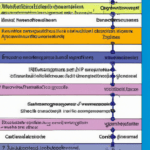Identification of policy gaps is a crucial aspect in the evaluation and improvement of existing policies. It involves recognizing the areas where the current policies fall short or fail to address specific issues effectively. By identifying these gaps, policymakers can develop strategies to bridge them and enhance the overall effectiveness of the policies. This process typically involves comprehensive assessments, data analysis, stakeholder engagement, and consultation with experts in the relevant field. Identification of policy gaps enables policymakers to make informed decisions, take appropriate actions, and implement necessary reforms to ensure that policies align with the evolving needs and challenges of society.
Identification of policy gaps refers to the process of identifying areas where existing policies are inadequate or do not address specific issues or challenges. It involves a systematic assessment and analysis to identify gaps between policy objectives and their implementation or outcomes. This process is crucial in order to develop effective and comprehensive policies that can address the evolving needs and concerns of society.
There are several approaches and methods used to identify policy gaps. One common method is through policy analysis, where existing policies are examined to identify any limitations, inconsistencies, or areas requiring improvement. This analysis involves reviewing policy documents, conducting stakeholder interviews, and examining the policy implementation process and outcomes.
Another approach is through monitoring and evaluation of policy implementation. This involves assessing the effectiveness and efficiency of policy measures in achieving their intended goals and outcomes. Through monitoring and evaluation, policymakers can identify any gaps between the policy objectives and the actual results, thereby allowing them to take corrective actions and make necessary improvements.
Additionally, conducting research and collecting data is essential for identifying policy gaps. Research can provide insights into emerging issues, changing societal needs, and gaps in knowledge or evidence that need to be addressed through policy interventions. Data collection and analysis help in understanding the current situation, identifying trends, and identifying areas where policies may not be effectively addressing the identified issues.
Moreover, engaging stakeholders and soliciting their feedback is vital in identifying policy gaps. Involving various stakeholders, such as experts, practitioners, civil society organizations, and affected communities, helps in understanding diverse perspectives and identifying gaps that may be overlooked from a single point of view.
In conclusion, identifying policy gaps is a crucial step in policy development and implementation. Through policy analysis, monitoring and evaluation, research, and stakeholder engagement, policymakers can identify areas where existing policies need improvement or where new policies are required to address emerging issues and meet societal needs effectively. This helps ensure that policies remain relevant, effective, and responsive to the changing dynamics of society.
Importance of identifying policy gaps
Identifying policy gaps is of utmost importance in the field of public administration and policy-making. It serves as a crucial step in the assessment and improvement of existing policies and the development of new ones. By recognizing and addressing gaps in policies, governments and organizations can effectively meet the needs of their constituents, tackle emerging challenges, and foster social progress. There are several key reasons why identifying policy gaps is essential.
First and foremost, policy gaps highlight areas where current policies may be ineffective or insufficient. They signal potential shortcomings in addressing specific issues or achieving desired outcomes. By identifying such gaps, policymakers can gain a deeper understanding of the challenges at hand, enabling them to design and implement more targeted and impactful interventions. Furthermore, this process facilitates evidence-based decision-making, as it prompts policy actors to gather data and analyze evidence to understand the root causes and consequences of the identified gaps.
Secondly, identifying policy gaps helps cultivate transparency and accountability in governance. It enables stakeholders to scrutinize existing policies, comparing the intended outcomes with the actual results. When gaps are identified, it becomes apparent which policies may require revision or improvement. This transparency fosters public trust and confidence in the policy-making process, and allows for meaningful engagement between policymakers and citizens. Through this process, citizens can participate in identifying policy gaps based on lived experiences and offer valuable insights for developing more inclusive and effective policies.
Moreover, recognizing policy gaps is essential for ensuring policy coherence and avoiding duplication or contradiction across different sectors or levels of government. It enables policymakers to coordinate their efforts, minimizing overlaps and gaps in addressing complex and interconnected issues. This promotes efficiency and synergy in policy implementation, as resources can be allocated more effectively to achieve desired objectives. By identifying and addressing policy gaps, governments can also avoid potential unintended consequences that may arise from disconnected policies.
Furthermore, policy gaps play a crucial role in promoting policy innovation and adaptation. As societal, economic, and technological landscapes continue to evolve rapidly, policies must be updated and adapted to meet new challenges. By identifying gaps, policymakers can generate innovative solutions that respond to emerging needs and trends. It encourages flexibility and agility in policy design and implementation, allowing policies to remain relevant and effective in a dynamic and ever-changing environment.
In conclusion, identifying policy gaps is vital for effective policy-making and public administration. It ensures the efficiency, coherence, and adaptability of policies, as well as transparency and accountability in governance. By addressing these gaps, policymakers can devise more targeted and impactful interventions, better meet the needs of their constituents, and foster social progress. As policy environments become increasingly complex, the importance of identifying policy gaps will only grow, urging policymakers to embrace this critical step in the policy-making process.
Methods for identifying policy gaps
Methods for identifying policy gaps involve various techniques and approaches that help policymakers assess the effectiveness and adequacy of existing policies. These methods aim to identify areas where policy interventions may be lacking or falling short in achieving desired outcomes. Here are some commonly used methods for identifying policy gaps:
Policy analysis: This method involves a systematic examination of existing policies, including their objectives, design, implementation, and outcomes. It helps to identify any discrepancies between policy intentions and actual results, highlighting areas where gaps may exist.
Stakeholder consultation: Engaging with a range of stakeholders such as experts, affected communities, civil society organizations, and industry representatives can provide valuable insights into policy effectiveness. Gathering feedback and opinions from these stakeholders can help identify potential gaps and shortcomings in policies.
Literature review: Conducting a comprehensive review of academic research, case studies, and policy evaluations can provide a deeper understanding of existing policies and their impact. This method can reveal any gaps in knowledge or evidence that may hinder policy effectiveness.
Data analysis: Examining relevant data sets and conducting statistical analyses can provide valuable insights into policy performance. By identifying trends, patterns, and disparities, policymakers can detect policy gaps that need to be addressed.
Comparative analysis: Comparing policies and outcomes across different jurisdictions or countries can reveal variations in approaches and results. This method can help identify innovative practices and potential gaps in local policy frameworks.
Impact assessments: Conducting formal impact assessments, such as social, environmental, or health impact assessments, can help identify policy gaps. By evaluating the potential impacts of policies on various aspects, policymakers can identify areas where interventions may be lacking or inadequate.
Monitoring and evaluation: Establishing robust monitoring and evaluation mechanisms allows policymakers to track policy implementation and outcomes systematically. Regular evaluation of policies can help identify any gaps in achieving desired objectives and inform necessary adjustments.
Expert panels and advisory groups: Engaging subject-matter experts through expert panels or advisory groups can provide valuable input on the effectiveness of existing policies. Their expertise can help identify gaps and propose solutions based on their knowledge and experience.
Policy mapping and gap analysis: Conducting a systematic mapping of policies in a specific domain and analyzing the relationships between them can highlight any gaps or overlaps. Gap analysis can then help identify areas where policy interventions are missing or insufficient.
By employing these methods, policymakers can gain a comprehensive understanding of policy gaps and devise strategies to address them. It is important to note that these methods are not exhaustive and can be combined or tailored to specific policy contexts and objectives.
Case studies of policy gaps in different sectors
Case studies of policy gaps in different sectors help shed light on the shortcomings and challenges faced by various industries and areas of governance. These practical examples highlight the need for effective policy development and implementation to address important issues. Here are a few case studies of policy gaps in different sectors:
1. Healthcare Sector:
Inadequate policies in the healthcare sector can lead to a range of problems, including limited access to quality healthcare, high costs, and insufficient resources. A case study might examine a country where the policy does not prioritize preventive care, resulting in a higher burden of disease and increased healthcare costs in the long run.
2. Education Sector:
Policy gaps in the education sector often revolve around issues such as unequal access, inadequate funding, and outdated curriculum. For instance, a case study could focus on a region where the education policy fails to address the educational needs of marginalized communities, leading to lower literacy rates and limited opportunities for these groups.
3. Environmental Sector:
In the face of growing concerns over climate change and environmental degradation, policy gaps can hinder sustainable practices and conservation efforts. A case study might explore a country that lacks comprehensive policies to regulate industrial waste disposal, leading to environmental pollution and health hazards for communities living near affected areas.
4. Transportation Sector:
Inefficient transportation policies can result in traffic congestion, air pollution, and compromised safety. A case study could highlight a city where inadequate investment in public transportation infrastructure leads to heavy reliance on private vehicles, exacerbating congestion and decreasing mobility options for residents.
5. Housing Sector:
Policy gaps in the housing sector can contribute to issues such as inadequate affordable housing, urban sprawl, and homelessness. A case study might examine a jurisdiction where the housing policy fails to adequately address the needs of low-income individuals and families, resulting in a shortage of affordable housing options and an increase in homelessness.
6. Employment Sector:
Policy gaps in the employment sector often relate to issues like labor laws, minimum wage, and job security. A case study could focus on a country where there are gaps in labor protection policies, leading to exploitative working conditions, unfair wages, and diminished workers’ rights.
These case studies demonstrate the importance of identifying and addressing policy gaps in different sectors. They serve as reminders that effective policies are crucial for creating sustainable and inclusive societies. Through an examination of these examples, policymakers, researchers, and advocates can gain insights into the specific challenges faced in different sectors and work towards developing comprehensive and effective policies to bridge the identified gaps.
Impacts of policy gaps on society
Impacts of policy gaps on society can be far-reaching and have significant consequences for various aspects of people’s lives. When policies are poorly implemented, outdated, or inadequate, it can create a variety of negative effects on individuals, communities, and society as a whole.
One of the key impacts of policy gaps on society is the unequal distribution of resources and opportunities. Inadequate policies often fail to address the needs of marginalized groups, leading to disparities in access to healthcare, education, employment, and other critical services. This can perpetuate social inequalities and widen the gap between different segments of society.
Policy gaps can also hinder economic growth and development. When there are inconsistencies and inefficiencies in policies related to business regulations, taxation, or international trade, it can create barriers that discourage investment and hinder economic progress. This can lead to stagnation, reduced competitiveness, and a loss of economic opportunities.
Furthermore, policy gaps can have detrimental effects on public health and safety. For example, if there are gaps in regulations and enforcement related to environmental protection, it can result in increased pollution, health hazards, and a decline in overall well-being. Similarly, gaps in policies addressing crime prevention, drug control, or public safety can undermine efforts to maintain law and order, leading to higher crime rates and a sense of insecurity within communities.
Policy gaps can also impact social cohesion and trust in institutions. When people perceive that policies are biased, inconsistent, or ineffective, it can erode their faith in the government and public institutions. This can lead to social unrest, protests, and a breakdown of community cohesion. In extreme cases, the lack of confidence in the system can contribute to political instability and conflicts within a society.
Moreover, policy gaps can impede sustainable development and environmental conservation efforts. When there are insufficient policies in place to promote environmental sustainability, protect natural resources, and mitigate the impacts of climate change, it can result in irreparable damage to ecosystems and natural habitats. This can have long-term consequences for future generations, who will be left to deal with the environmental degradation caused by policy gaps today.
In conclusion, policy gaps have wide-ranging impacts on society. They can exacerbate social inequalities, hinder economic growth, compromise public health and safety, undermine social cohesion, and impede sustainable development. Addressing these policy gaps and ensuring effective implementation of policies is crucial to creating a fair, prosperous, and inclusive society.
Strategies for addressing and filling policy gaps
Strategies for addressing and filling policy gaps involve a comprehensive approach to identifying, understanding, and closing the loopholes and deficiencies in existing policies. These strategies aim to improve governance, enhance policy effectiveness, and ensure that the intended goals and outcomes of policies are achieved. Here are some key strategies that can be employed:
1. Gap analysis: Conducting a thorough gap analysis is crucial to understanding the shortcomings and areas where policies fall short. This involves comparing actual policy implementation and outcomes to the intended goals and identifying the gaps that prevent the desired results. This analysis provides a foundation for further action.
2. Stakeholder engagement: Engaging relevant stakeholders is essential in understanding the perspectives and concerns of those affected by the policy gaps. By involving relevant individuals and organizations, policymakers can gain valuable insights and input to develop targeted and effective strategies for addressing and filling the gaps.
3. Research and data collection: Implementing policies based on solid research and data is crucial. Collecting and analyzing relevant data, conducting impact assessments, and identifying evidence-based best practices are essential strategies for addressing policy gaps. This approach helps policymakers develop informed and effective solutions that address the root causes of the gaps.
4. Policy reform and revision: Sometimes, policy gaps result from outdated or ineffective policies. Strategies for addressing and filling these gaps often involve reforming existing policies, revising regulations, and adjusting frameworks to align with the current context and evolving needs. Continuous evaluation and adaptation are key to closing policy gaps effectively.
5. Capacity building: Improving the capacity of government agencies, policymakers, and other relevant stakeholders is essential for effective policy implementation. Providing training, resources, and support to enhance knowledge, skills, and abilities helps address gaps in understanding and implementation, improving overall policy performance.
6. Collaboration and partnerships: Addressing policy gaps often requires collaboration between different government agencies, civil society organizations, and other stakeholders. Establishing partnerships can leverage diverse resources, expertise, and perspectives to develop comprehensive strategies for addressing and filling policy gaps.
7. Monitoring and evaluation: Regular monitoring and evaluation of policy implementation are crucial to identifying and addressing gaps. Adopting robust monitoring mechanisms, collecting relevant data, and analyzing outcomes allow policymakers to identify areas of weakness, track progress, and make necessary adjustments to ensure policies are effective.
8. Policy innovation: Encouraging policy innovation and experimentation can help fill policy gaps. This strategy involves piloting new approaches, learning from successes and failures, and scaling up successful initiatives to address gaps effectively. Embracing innovation allows policymakers to adapt to emerging challenges and changing conditions.
Addressing and filling policy gaps is a continuous and dynamic process. By employing these strategies and adopting a proactive approach, policymakers can ensure that policies are effective, efficient, and responsive to the needs of society.
External Links
- Research Ethics Review: Identifying Public Policy and Program Gaps
- Aligning Agent-Based Modeling With Multi-Objective … – Frontiers
- Security and Privacy Policy Languages: A Survey, Categorization …
- Identifying Gaps in Federal Oversight of Hospitals’ Community …
- Identifying gaps in HIV policy and practice along the HIV care …













